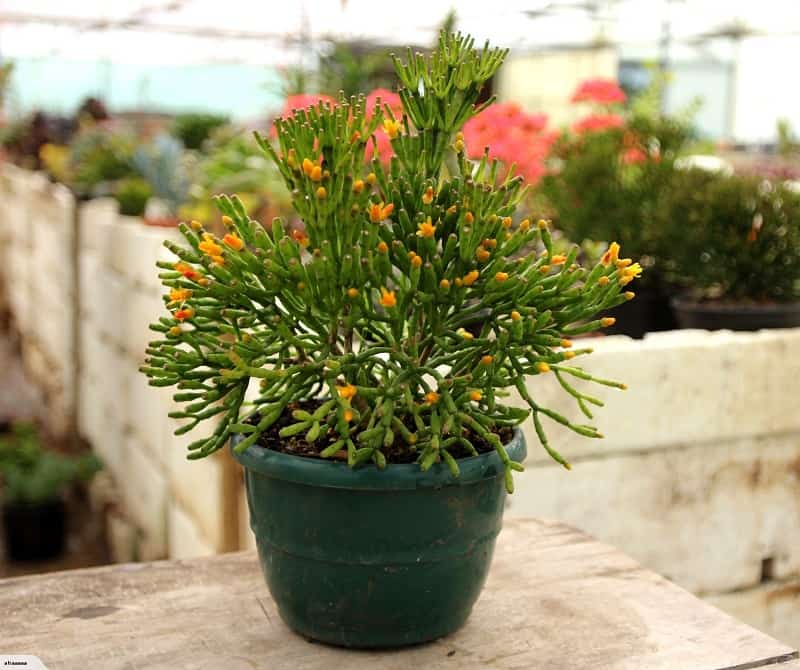Hatiora salicornioides is a botanical species of plant, belonging to the family of Cactaceae.
It is endemic to Bahia, Espírito Santo, Minas Gerais, Paraná, Rio de Janeiro and São Paulo in Brazil.
Hatiora salicornioides has a branched growth with erect arched or hanging stems and its stems become woody over time.
The stems are dark green, bright, deeply segmented into small and thin cylindrical structures, between 2 or 5 centimeters in length.
The ends of the stems are divided into two, four or six segments.
They have terminal areolas covered with fine whitish hairiness that gives the plant a very original appearance.
The flowers develop at the end of their stems, which are small and do not exceed two centimeters in length and are bright orange-yellow.
Its flowering is very abundant and decorative.
When its flowers wilt the fruits begin to develop, these are small and rounded in translucent white.
When the Hatiora salicornioides develops the flower buds, it is advisable not to rotate or move the plant, since the buds are very delicate as the flowers and fall easily if we change the position of the plant.
You may like Kalanchoe Bracteata
Tips to take care of the Hatiora Salicornioides “Dancing Bones Plant”
Illumination
It prefers luminous situations without direct sun, but they are resistant to direct sunlight in the early hours of the morning or late in the afternoon.
We can grow it outdoors in climates with moderate winter temperatures, it can also be grown as an indoor plant, away from heating and air currents.
If we grow the plant in climates with high temperatures, it is advisable to protect the plants from direct sun, especially in the central hours of the day.
Direct summer sun can cause burns on their stems.
In general, it is a very resistant and easy to grow, low maintenance plant.
Substratum
You need a loose and well-drained soil that contains peat and sand to facilitate drainage of the plant.
Remember the substrate must have good drainage, since these types of plants are very susceptible to excess water because this can rot the roots and cause death to the plant.
Fertilizer
During the spring and summer, it is advisable to apply special mineral fertilizer for succulents and cactus plants at half the recommended dose, once every fifteen days.
In fall and winter do not pay.
Watering
You need moderate watering during spring and summer, in fall and winter low watering, even eliminate watering completely if the temperatures are very low and we grow it in a humid environment.
After flowering needs rest, it is advisable to water very little so that the plant recovers favorably.
If you do not know when to water the plant, the only thing you should keep in mind is to wait for the substrate to be completely dry between irrigation and irrigation, especially in winter to avoid waterlogging.
Temperatures
It prefers annual temperatures between 24 ° C to 27 ° C, to grow and develop properly. It is advisable to grow it outdoors if winter temperatures are moderate and above 7 ° C or 8 ° C.
It is better to place them indoors, and thus they will be protected in case of sudden frosts.
In colder climates, it is better to grow them indoors or in greenhouses.
Pruning
It does not need pruning, but it responds very well to them, if we want to control their size or get more rounded and compact plants, we can trim the longer and less oriented stems.
We will make the cut near some growth bud, this way we will promote the birth of new shoots and a more decorative plant.
Propagation
It is a very easy plant to reproduce.
It reproduces by stem cuttings sown directly on land, we will use a substrate rich in peat and sand.
In a few weeks, the cuttings will generate roots.
We will place the pots in a shaded place and keep the substrate slightly damp.
After a few months, we will be pinching the end of the stems so that the new plants branch.
We can use the pruning remains to obtain cuttings.
Plagues and diseases
It is a very resistant plant, not usually affected by pests or diseases.
Its main enemies are the intense cold and the excess of water that can cause rot.
It is very important to water in moderation and provides the plant with a suitable and well substrate. Keep the plant protected from low temperatures and frost.
Conclusion
Hatiora salicornioides grows to about 1 m (3 ft) tall with an erect to pendent growth habit. Its stems are composed of segments 1.5–5 cm (0.6–2.0 in) long.
Each segment is shaped like a club or bottle, with the narrower end at the base.
The stems branch from the end of a segment, with up to six branches forming a whorl.
The yellow to orange flowers are borne at the ends of younger stem segments and are 1–2 cm (0.4–0.8 in) long and about the same across when open. Translucent white berries follow the flowers.
Plants produce an interesting display of contorted stems.
The distinct foliage makes these plants a great choice for adding more interest to a window or an existing cactus garden.
It’s not the hardest plant to grow, but there are a few care tips to follow.
Hope this article was a help if you have any other question please let me know. Always glad to help.
